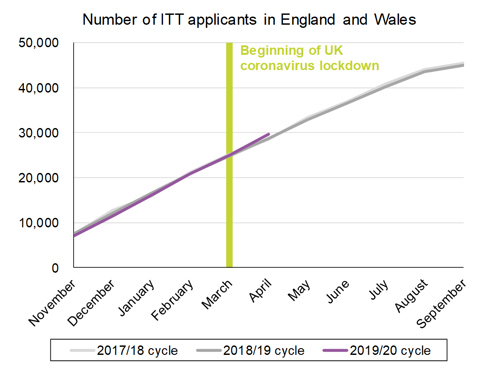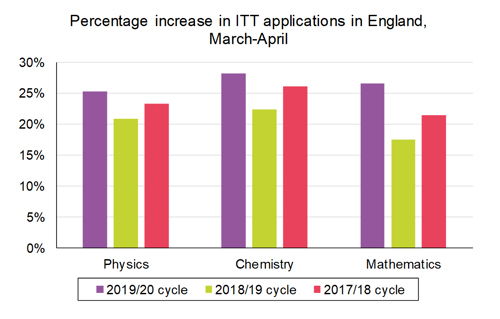What effect has the lockdown had on teacher supply?
Saturday 1 May 2021
 The coronavirus outbreak in the UK is having far-reaching effects on a huge number of aspects of people’s day-to-day lives and on the education system. However, new UCAS data suggests that it may also be easing the teacher supply challenge.
The coronavirus outbreak in the UK is having far-reaching effects on a huge number of aspects of people’s day-to-day lives and on the education system. However, new UCAS data suggests that it may also be easing the teacher supply challenge.
Before the coronavirus outbreak, the secondary teacher labour market in England was in a precarious state. The number of secondary teacher trainees required to maintain supply was high and rising due to high leaving rates and increasing demand from rising pupil numbers. At the same time recruitment of secondary teacher trainees was below the target for seven consecutive years.
The lockdown and school closures due to coronavirus are likely to have wide-ranging impacts on the teacher labour market, including on school recruitment, teachers’ decisions about whether or not to remain in teaching, teacher training courses and more. New data published today by UCAS suggests that coronavirus may have had a positive effect on applications to teacher training next year.
What happened to teacher training applications this month?
UCAS publishes monthly data on the number of initial teacher training (ITT) applications in England and Wales. The data up until the middle of March, when the UK lockdown began, shows that applications for the 2020/21 cycle were on a very similar trajectory to the two previous cycles.
The latest data published today, measuring applications up to mid-April, shows that the number of applicants have increased by more than would be expected by previous trends.

Source: UCAS Teacher Training statistics
The increase is small: the number of applicants is around 3 per cent above the two previous cycles, where there had been negligible differences up until March. It could also be a temporary blip, as this is just one month of data. Some other things are also different this year and may have contributed to the shift. For example, large increases in starting salaries were proposed before the December election, which will apply to this cohort of trainees, as will the national rollout of the Early Career Framework.
However, the timing of the increase suggests that the coronavirus lockdown is likely to be the crucial factor. It could reflect students getting their applications in early because they have more time due to the lockdown. There is also a good reason from economic theory that plausibly explains why this could represent an encouraging shift in the trend in teacher recruitment and may not be a short-lived effect.
The coronavirus outbreak has increased labour market insecurity, both directly through workers being made redundant or furloughed and indirectly as recruitment activity slows due to companies protecting their short-term financial positions during the uncertainty of the crisis. However, the demand for teachers and schools’ financial positions will remain comparatively unchanged during this period: there will always (once schools reopen) be children to teach.
Higher job security relative to other occupations makes teaching more attractive, as a safe haven occupation while the rest of the labour market looks much stormier.
There was a similar boost for teacher recruitment during the recession following the global financial crisis, the last period of great labour market uncertainty. Recruitment to teacher training in England in 2010/11 was above target for every subject. As we reported in our 2019 Teacher Labour Market in England Report, teaching’s traditional ‘recession-proof’ advantage over other professions has eroded since the recession, due to a relatively strong and secure graduate labour market.
As the teacher supply challenge has intensified in recent years, the government has made numerous policy interventions to try to increase recruitment. However, external factors with a strong influence on recruitment decisions, such as perceptions of relative job security, are difficult to shift with policy. It may be that coronavirus has given teacher recruitment the extra boost it needed, to complement the effect of the policy measures.
Are more shortage-subject teachers being attracted into teaching?
The complexity of meeting the teacher supply challenge, particularly for secondary schools, is that not every ITT application is of equal value to policymakers. As we explained in November, the ITT data from the 2019/20 cycle showed increasing under-recruitment in physics, chemistry and maths, while recruitment to history, English and biology were all recruiting above their target level. Increased recruitment in shortage subjects is key to meeting the teacher supply challenge.
UCAS data shows that the percentage increase in ITT applications between March and April has been higher than in previous years for all three subjects. This is a promising sign that if the upward shift in the recruitment trend continues, then it is likely to be felt across shortage and non-shortage subjects alike and help to fill current shortages.

Source: UCAS Teacher Training statistics
What is the overall impact of coronavirus on teacher supply?
The job security explanation is also likely to mean coronavirus may have a positive impact on teacher retention, as fewer teachers decide to leave teaching because the prospect of searching for another job looks increasingly risky. Combined with a possible upward trend in teacher recruitment, the coronavirus situation may therefore turn out to have a silver lining for teacher supply at a time when the challenge was beginning to look very daunting.
However, there are also potential risks that the sector needs to remain vigilant to. Ensuring teachers’ workload is manageable during school closures and as schools begin to reopen, and safeguarding their safety, health and well-being, is key to supporting current teachers through the crisis.
Teachers and school leaders across the country have shown enormous dedication to their work during the crisis, continuing to support their pupils’ educations while juggling the many challenges of working remotely, home-schooling and caring for relatives. That very visible dedication is also likely to make teaching more attractive to potential teachers in future, as the public increasingly respect the important work teachers do.
